Analyzing the Turnaround of Malaysia Airlines: A Case Study
VerifiedAdded on 2019/10/18
|11
|2410
|469
Case Study
AI Summary
This case study examines the financial crisis faced by Malaysia Airlines and the subsequent turnaround strategy implemented by Idris Jala. It details the application of Six Sigma methodologies, specifically the DMAIC (Define, Measure, Analyze, Improve, Control) process and the Fishbone diagram, to identify and address the airline's operational and financial challenges. The analysis focuses on issues such as low yield, inefficient networks, and high costs, including excessive hiring and unprofitable routes. The study highlights how Idris Jala implemented cost-cutting measures, route adjustments, and workforce reductions to improve the airline's profitability and operational efficiency. The case underscores the importance of leadership, strategic decision-making, and the effective use of data-driven tools in turning around a struggling business in a competitive environment.
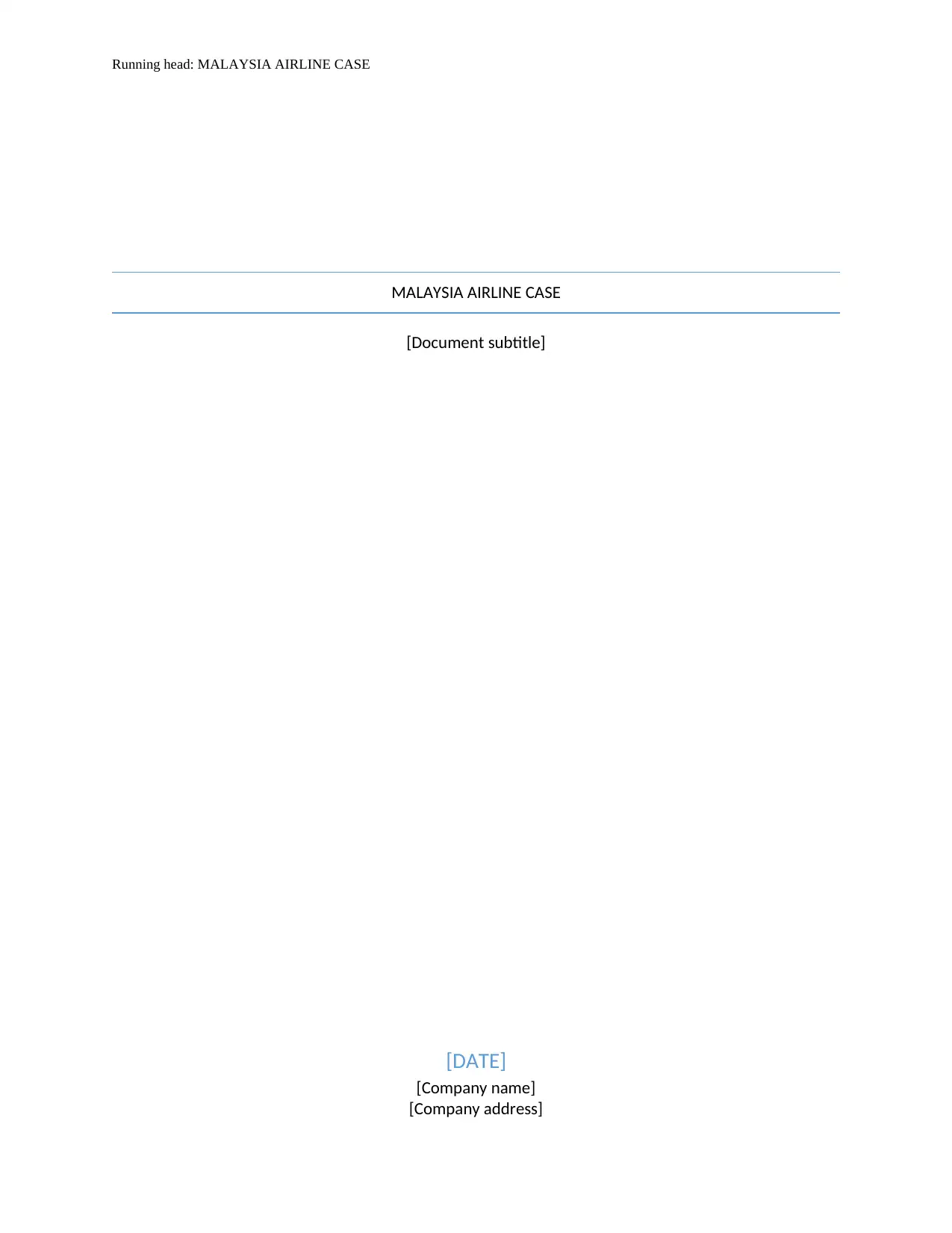
Running head: MALAYSIA AIRLINE CASE
MALAYSIA AIRLINE CASE
[Document subtitle]
[DATE]
[Company name]
[Company address]
MALAYSIA AIRLINE CASE
[Document subtitle]
[DATE]
[Company name]
[Company address]
Paraphrase This Document
Need a fresh take? Get an instant paraphrase of this document with our AI Paraphraser
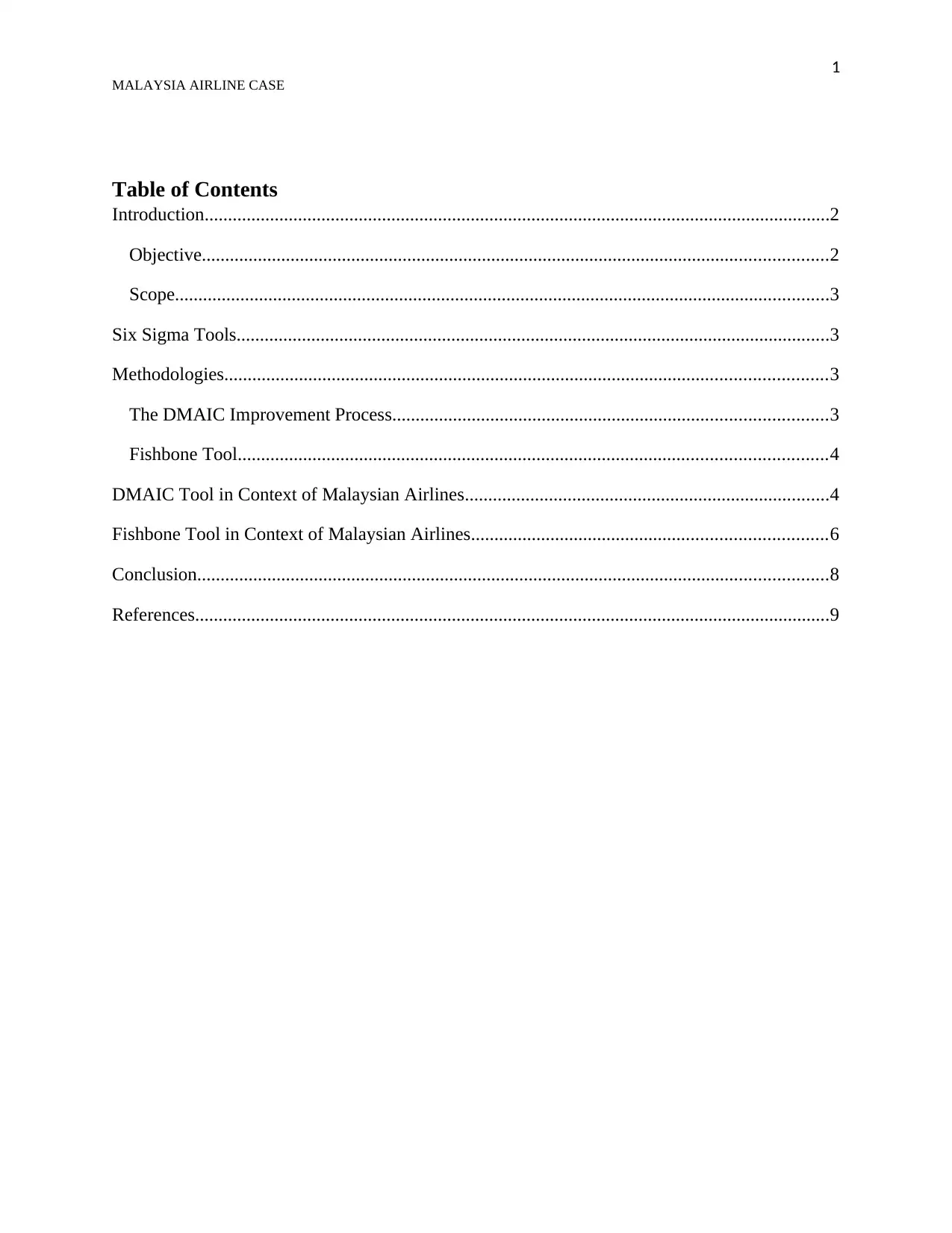
1
MALAYSIA AIRLINE CASE
Table of Contents
Introduction......................................................................................................................................2
Objective......................................................................................................................................2
Scope............................................................................................................................................3
Six Sigma Tools...............................................................................................................................3
Methodologies.................................................................................................................................3
The DMAIC Improvement Process.............................................................................................3
Fishbone Tool..............................................................................................................................4
DMAIC Tool in Context of Malaysian Airlines..............................................................................4
Fishbone Tool in Context of Malaysian Airlines............................................................................6
Conclusion.......................................................................................................................................8
References........................................................................................................................................9
MALAYSIA AIRLINE CASE
Table of Contents
Introduction......................................................................................................................................2
Objective......................................................................................................................................2
Scope............................................................................................................................................3
Six Sigma Tools...............................................................................................................................3
Methodologies.................................................................................................................................3
The DMAIC Improvement Process.............................................................................................3
Fishbone Tool..............................................................................................................................4
DMAIC Tool in Context of Malaysian Airlines..............................................................................4
Fishbone Tool in Context of Malaysian Airlines............................................................................6
Conclusion.......................................................................................................................................8
References........................................................................................................................................9
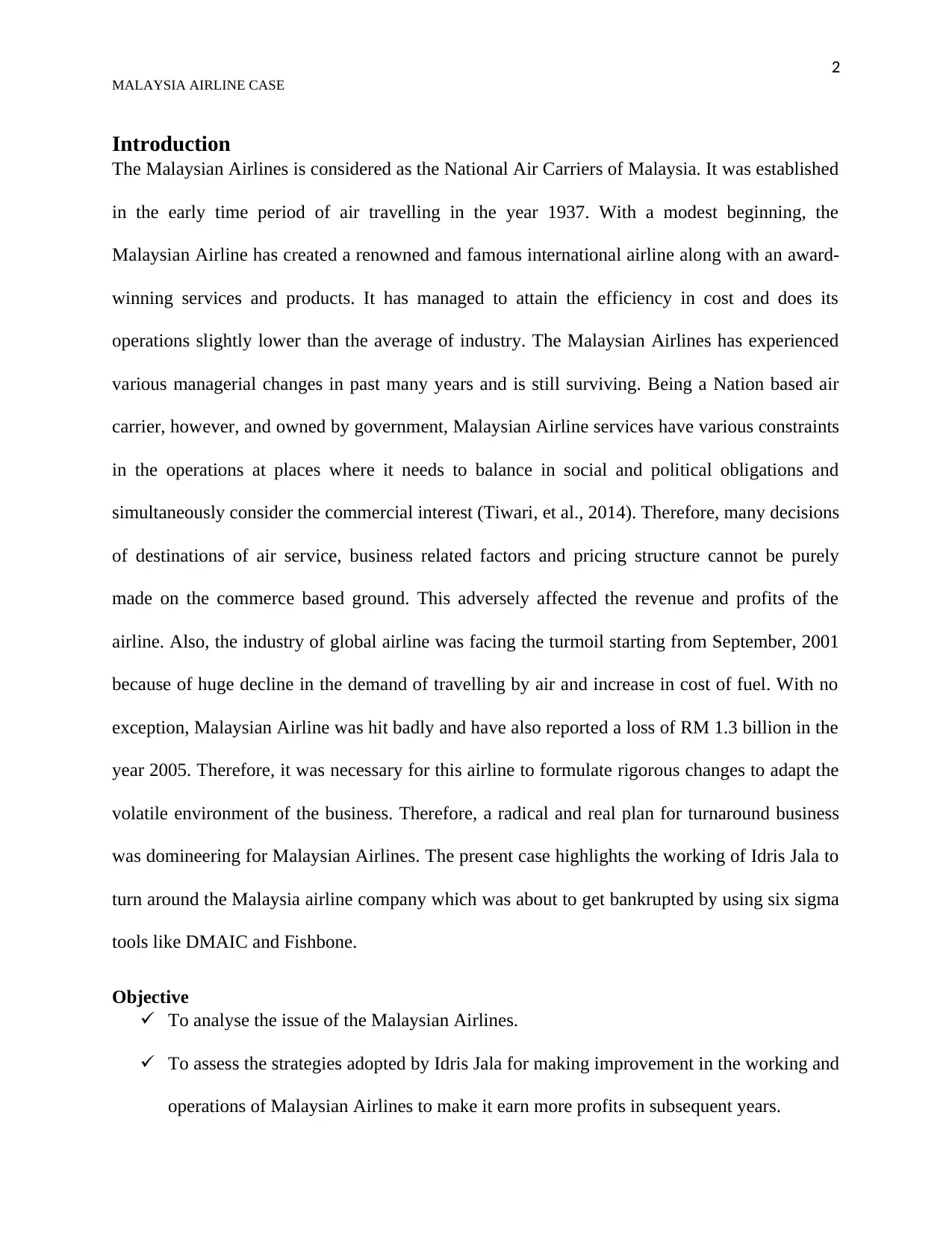
2
MALAYSIA AIRLINE CASE
Introduction
The Malaysian Airlines is considered as the National Air Carriers of Malaysia. It was established
in the early time period of air travelling in the year 1937. With a modest beginning, the
Malaysian Airline has created a renowned and famous international airline along with an award-
winning services and products. It has managed to attain the efficiency in cost and does its
operations slightly lower than the average of industry. The Malaysian Airlines has experienced
various managerial changes in past many years and is still surviving. Being a Nation based air
carrier, however, and owned by government, Malaysian Airline services have various constraints
in the operations at places where it needs to balance in social and political obligations and
simultaneously consider the commercial interest (Tiwari, et al., 2014). Therefore, many decisions
of destinations of air service, business related factors and pricing structure cannot be purely
made on the commerce based ground. This adversely affected the revenue and profits of the
airline. Also, the industry of global airline was facing the turmoil starting from September, 2001
because of huge decline in the demand of travelling by air and increase in cost of fuel. With no
exception, Malaysian Airline was hit badly and have also reported a loss of RM 1.3 billion in the
year 2005. Therefore, it was necessary for this airline to formulate rigorous changes to adapt the
volatile environment of the business. Therefore, a radical and real plan for turnaround business
was domineering for Malaysian Airlines. The present case highlights the working of Idris Jala to
turn around the Malaysia airline company which was about to get bankrupted by using six sigma
tools like DMAIC and Fishbone.
Objective
To analyse the issue of the Malaysian Airlines.
To assess the strategies adopted by Idris Jala for making improvement in the working and
operations of Malaysian Airlines to make it earn more profits in subsequent years.
MALAYSIA AIRLINE CASE
Introduction
The Malaysian Airlines is considered as the National Air Carriers of Malaysia. It was established
in the early time period of air travelling in the year 1937. With a modest beginning, the
Malaysian Airline has created a renowned and famous international airline along with an award-
winning services and products. It has managed to attain the efficiency in cost and does its
operations slightly lower than the average of industry. The Malaysian Airlines has experienced
various managerial changes in past many years and is still surviving. Being a Nation based air
carrier, however, and owned by government, Malaysian Airline services have various constraints
in the operations at places where it needs to balance in social and political obligations and
simultaneously consider the commercial interest (Tiwari, et al., 2014). Therefore, many decisions
of destinations of air service, business related factors and pricing structure cannot be purely
made on the commerce based ground. This adversely affected the revenue and profits of the
airline. Also, the industry of global airline was facing the turmoil starting from September, 2001
because of huge decline in the demand of travelling by air and increase in cost of fuel. With no
exception, Malaysian Airline was hit badly and have also reported a loss of RM 1.3 billion in the
year 2005. Therefore, it was necessary for this airline to formulate rigorous changes to adapt the
volatile environment of the business. Therefore, a radical and real plan for turnaround business
was domineering for Malaysian Airlines. The present case highlights the working of Idris Jala to
turn around the Malaysia airline company which was about to get bankrupted by using six sigma
tools like DMAIC and Fishbone.
Objective
To analyse the issue of the Malaysian Airlines.
To assess the strategies adopted by Idris Jala for making improvement in the working and
operations of Malaysian Airlines to make it earn more profits in subsequent years.
⊘ This is a preview!⊘
Do you want full access?
Subscribe today to unlock all pages.

Trusted by 1+ million students worldwide
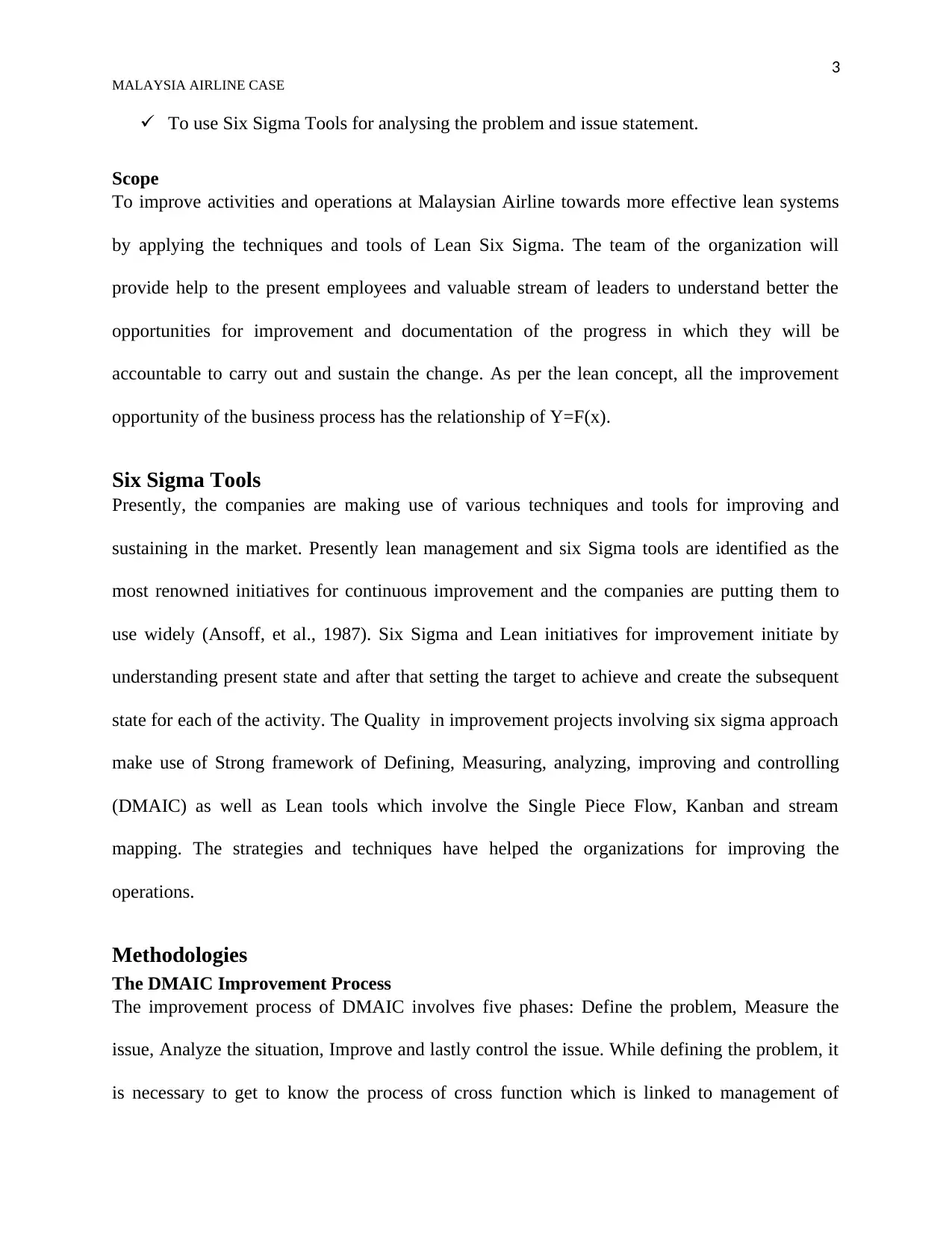
3
MALAYSIA AIRLINE CASE
To use Six Sigma Tools for analysing the problem and issue statement.
Scope
To improve activities and operations at Malaysian Airline towards more effective lean systems
by applying the techniques and tools of Lean Six Sigma. The team of the organization will
provide help to the present employees and valuable stream of leaders to understand better the
opportunities for improvement and documentation of the progress in which they will be
accountable to carry out and sustain the change. As per the lean concept, all the improvement
opportunity of the business process has the relationship of Y=F(x).
Six Sigma Tools
Presently, the companies are making use of various techniques and tools for improving and
sustaining in the market. Presently lean management and six Sigma tools are identified as the
most renowned initiatives for continuous improvement and the companies are putting them to
use widely (Ansoff, et al., 1987). Six Sigma and Lean initiatives for improvement initiate by
understanding present state and after that setting the target to achieve and create the subsequent
state for each of the activity. The Quality in improvement projects involving six sigma approach
make use of Strong framework of Defining, Measuring, analyzing, improving and controlling
(DMAIC) as well as Lean tools which involve the Single Piece Flow, Kanban and stream
mapping. The strategies and techniques have helped the organizations for improving the
operations.
Methodologies
The DMAIC Improvement Process
The improvement process of DMAIC involves five phases: Define the problem, Measure the
issue, Analyze the situation, Improve and lastly control the issue. While defining the problem, it
is necessary to get to know the process of cross function which is linked to management of
MALAYSIA AIRLINE CASE
To use Six Sigma Tools for analysing the problem and issue statement.
Scope
To improve activities and operations at Malaysian Airline towards more effective lean systems
by applying the techniques and tools of Lean Six Sigma. The team of the organization will
provide help to the present employees and valuable stream of leaders to understand better the
opportunities for improvement and documentation of the progress in which they will be
accountable to carry out and sustain the change. As per the lean concept, all the improvement
opportunity of the business process has the relationship of Y=F(x).
Six Sigma Tools
Presently, the companies are making use of various techniques and tools for improving and
sustaining in the market. Presently lean management and six Sigma tools are identified as the
most renowned initiatives for continuous improvement and the companies are putting them to
use widely (Ansoff, et al., 1987). Six Sigma and Lean initiatives for improvement initiate by
understanding present state and after that setting the target to achieve and create the subsequent
state for each of the activity. The Quality in improvement projects involving six sigma approach
make use of Strong framework of Defining, Measuring, analyzing, improving and controlling
(DMAIC) as well as Lean tools which involve the Single Piece Flow, Kanban and stream
mapping. The strategies and techniques have helped the organizations for improving the
operations.
Methodologies
The DMAIC Improvement Process
The improvement process of DMAIC involves five phases: Define the problem, Measure the
issue, Analyze the situation, Improve and lastly control the issue. While defining the problem, it
is necessary to get to know the process of cross function which is linked to management of
Paraphrase This Document
Need a fresh take? Get an instant paraphrase of this document with our AI Paraphraser
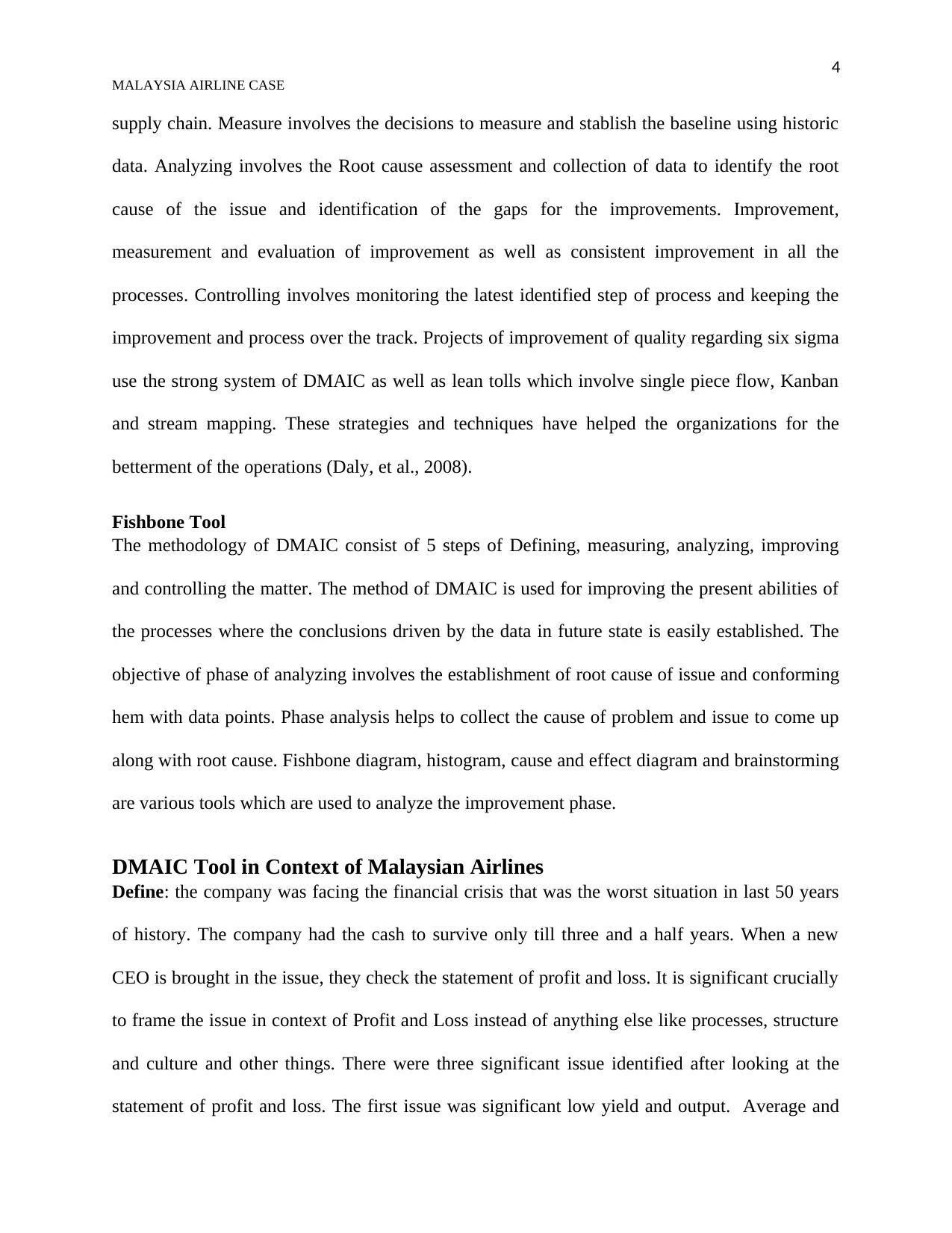
4
MALAYSIA AIRLINE CASE
supply chain. Measure involves the decisions to measure and stablish the baseline using historic
data. Analyzing involves the Root cause assessment and collection of data to identify the root
cause of the issue and identification of the gaps for the improvements. Improvement,
measurement and evaluation of improvement as well as consistent improvement in all the
processes. Controlling involves monitoring the latest identified step of process and keeping the
improvement and process over the track. Projects of improvement of quality regarding six sigma
use the strong system of DMAIC as well as lean tolls which involve single piece flow, Kanban
and stream mapping. These strategies and techniques have helped the organizations for the
betterment of the operations (Daly, et al., 2008).
Fishbone Tool
The methodology of DMAIC consist of 5 steps of Defining, measuring, analyzing, improving
and controlling the matter. The method of DMAIC is used for improving the present abilities of
the processes where the conclusions driven by the data in future state is easily established. The
objective of phase of analyzing involves the establishment of root cause of issue and conforming
hem with data points. Phase analysis helps to collect the cause of problem and issue to come up
along with root cause. Fishbone diagram, histogram, cause and effect diagram and brainstorming
are various tools which are used to analyze the improvement phase.
DMAIC Tool in Context of Malaysian Airlines
Define: the company was facing the financial crisis that was the worst situation in last 50 years
of history. The company had the cash to survive only till three and a half years. When a new
CEO is brought in the issue, they check the statement of profit and loss. It is significant crucially
to frame the issue in context of Profit and Loss instead of anything else like processes, structure
and culture and other things. There were three significant issue identified after looking at the
statement of profit and loss. The first issue was significant low yield and output. Average and
MALAYSIA AIRLINE CASE
supply chain. Measure involves the decisions to measure and stablish the baseline using historic
data. Analyzing involves the Root cause assessment and collection of data to identify the root
cause of the issue and identification of the gaps for the improvements. Improvement,
measurement and evaluation of improvement as well as consistent improvement in all the
processes. Controlling involves monitoring the latest identified step of process and keeping the
improvement and process over the track. Projects of improvement of quality regarding six sigma
use the strong system of DMAIC as well as lean tolls which involve single piece flow, Kanban
and stream mapping. These strategies and techniques have helped the organizations for the
betterment of the operations (Daly, et al., 2008).
Fishbone Tool
The methodology of DMAIC consist of 5 steps of Defining, measuring, analyzing, improving
and controlling the matter. The method of DMAIC is used for improving the present abilities of
the processes where the conclusions driven by the data in future state is easily established. The
objective of phase of analyzing involves the establishment of root cause of issue and conforming
hem with data points. Phase analysis helps to collect the cause of problem and issue to come up
along with root cause. Fishbone diagram, histogram, cause and effect diagram and brainstorming
are various tools which are used to analyze the improvement phase.
DMAIC Tool in Context of Malaysian Airlines
Define: the company was facing the financial crisis that was the worst situation in last 50 years
of history. The company had the cash to survive only till three and a half years. When a new
CEO is brought in the issue, they check the statement of profit and loss. It is significant crucially
to frame the issue in context of Profit and Loss instead of anything else like processes, structure
and culture and other things. There were three significant issue identified after looking at the
statement of profit and loss. The first issue was significant low yield and output. Average and
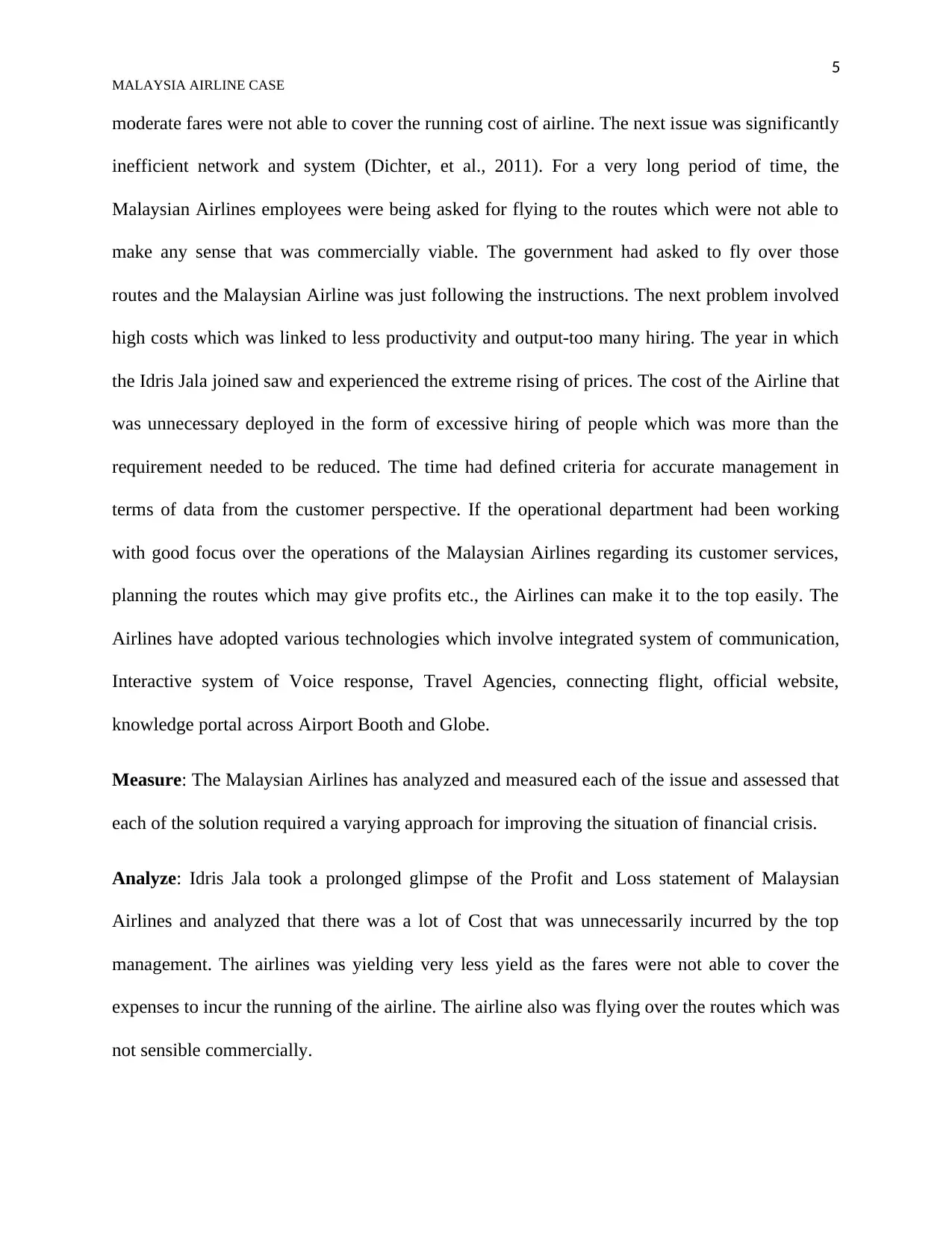
5
MALAYSIA AIRLINE CASE
moderate fares were not able to cover the running cost of airline. The next issue was significantly
inefficient network and system (Dichter, et al., 2011). For a very long period of time, the
Malaysian Airlines employees were being asked for flying to the routes which were not able to
make any sense that was commercially viable. The government had asked to fly over those
routes and the Malaysian Airline was just following the instructions. The next problem involved
high costs which was linked to less productivity and output-too many hiring. The year in which
the Idris Jala joined saw and experienced the extreme rising of prices. The cost of the Airline that
was unnecessary deployed in the form of excessive hiring of people which was more than the
requirement needed to be reduced. The time had defined criteria for accurate management in
terms of data from the customer perspective. If the operational department had been working
with good focus over the operations of the Malaysian Airlines regarding its customer services,
planning the routes which may give profits etc., the Airlines can make it to the top easily. The
Airlines have adopted various technologies which involve integrated system of communication,
Interactive system of Voice response, Travel Agencies, connecting flight, official website,
knowledge portal across Airport Booth and Globe.
Measure: The Malaysian Airlines has analyzed and measured each of the issue and assessed that
each of the solution required a varying approach for improving the situation of financial crisis.
Analyze: Idris Jala took a prolonged glimpse of the Profit and Loss statement of Malaysian
Airlines and analyzed that there was a lot of Cost that was unnecessarily incurred by the top
management. The airlines was yielding very less yield as the fares were not able to cover the
expenses to incur the running of the airline. The airline also was flying over the routes which was
not sensible commercially.
MALAYSIA AIRLINE CASE
moderate fares were not able to cover the running cost of airline. The next issue was significantly
inefficient network and system (Dichter, et al., 2011). For a very long period of time, the
Malaysian Airlines employees were being asked for flying to the routes which were not able to
make any sense that was commercially viable. The government had asked to fly over those
routes and the Malaysian Airline was just following the instructions. The next problem involved
high costs which was linked to less productivity and output-too many hiring. The year in which
the Idris Jala joined saw and experienced the extreme rising of prices. The cost of the Airline that
was unnecessary deployed in the form of excessive hiring of people which was more than the
requirement needed to be reduced. The time had defined criteria for accurate management in
terms of data from the customer perspective. If the operational department had been working
with good focus over the operations of the Malaysian Airlines regarding its customer services,
planning the routes which may give profits etc., the Airlines can make it to the top easily. The
Airlines have adopted various technologies which involve integrated system of communication,
Interactive system of Voice response, Travel Agencies, connecting flight, official website,
knowledge portal across Airport Booth and Globe.
Measure: The Malaysian Airlines has analyzed and measured each of the issue and assessed that
each of the solution required a varying approach for improving the situation of financial crisis.
Analyze: Idris Jala took a prolonged glimpse of the Profit and Loss statement of Malaysian
Airlines and analyzed that there was a lot of Cost that was unnecessarily incurred by the top
management. The airlines was yielding very less yield as the fares were not able to cover the
expenses to incur the running of the airline. The airline also was flying over the routes which was
not sensible commercially.
⊘ This is a preview!⊘
Do you want full access?
Subscribe today to unlock all pages.

Trusted by 1+ million students worldwide

6
MALAYSIA AIRLINE CASE
Improvement: The core competency of Malaysian Airlines lies in the ability to offer continually
to offer less tariffs. Primarily, Malaysian Airlines income is earned from Secondary activities
and logistics services like maintenance of aircraft and technological development. By
coordinating the activities of value Chain Analysis, the Malaysian Airlines may have less cost
structure and high value of resulting product.
Control: After analyzing the issue with the Malaysian Airlines, Idris Jala took this decision to
alter the policies of the existence governance ad take bold steps to formulate new policies. The
routes which are not creating any profit must be shut down. The unnecessary hiring of people
should be stopped to lower the incurring of cost over those people whose productivity is not
required sur to oversupply of manpower. The fares were not enough for covering the running
cost of the flight.
Fishbone Tool in Context of Malaysian Airlines
The diagram of Cause and Effect also known as “Fishbone” Diagram help to brainstorm and
identify the probable causes of the problem. The Fishbone Diagram is visualized to look over the
cause and effect analysis. It is an approach which is more structured than any other available tool
to brainstorm the reasons behind the problem. The effect and cause is depicted at the mouth or
head of fish. The possible cause which are contributing are at the small bones below various
categories. The tool of fishbone is helpful to identify the probable causes for the issue which
otherwise might not be considered and it directs the team for looking over the categories and
thinking about the alternative causes (John, et al., 2013).
Under the Management head, it was identified by Idris Jala that the first issue was significant
low yield and output. Average and moderate fares were not able to cover the running cost of
airline. As per the environmental concerns the reputation and goodwill of the Airlines was
MALAYSIA AIRLINE CASE
Improvement: The core competency of Malaysian Airlines lies in the ability to offer continually
to offer less tariffs. Primarily, Malaysian Airlines income is earned from Secondary activities
and logistics services like maintenance of aircraft and technological development. By
coordinating the activities of value Chain Analysis, the Malaysian Airlines may have less cost
structure and high value of resulting product.
Control: After analyzing the issue with the Malaysian Airlines, Idris Jala took this decision to
alter the policies of the existence governance ad take bold steps to formulate new policies. The
routes which are not creating any profit must be shut down. The unnecessary hiring of people
should be stopped to lower the incurring of cost over those people whose productivity is not
required sur to oversupply of manpower. The fares were not enough for covering the running
cost of the flight.
Fishbone Tool in Context of Malaysian Airlines
The diagram of Cause and Effect also known as “Fishbone” Diagram help to brainstorm and
identify the probable causes of the problem. The Fishbone Diagram is visualized to look over the
cause and effect analysis. It is an approach which is more structured than any other available tool
to brainstorm the reasons behind the problem. The effect and cause is depicted at the mouth or
head of fish. The possible cause which are contributing are at the small bones below various
categories. The tool of fishbone is helpful to identify the probable causes for the issue which
otherwise might not be considered and it directs the team for looking over the categories and
thinking about the alternative causes (John, et al., 2013).
Under the Management head, it was identified by Idris Jala that the first issue was significant
low yield and output. Average and moderate fares were not able to cover the running cost of
airline. As per the environmental concerns the reputation and goodwill of the Airlines was
Paraphrase This Document
Need a fresh take? Get an instant paraphrase of this document with our AI Paraphraser
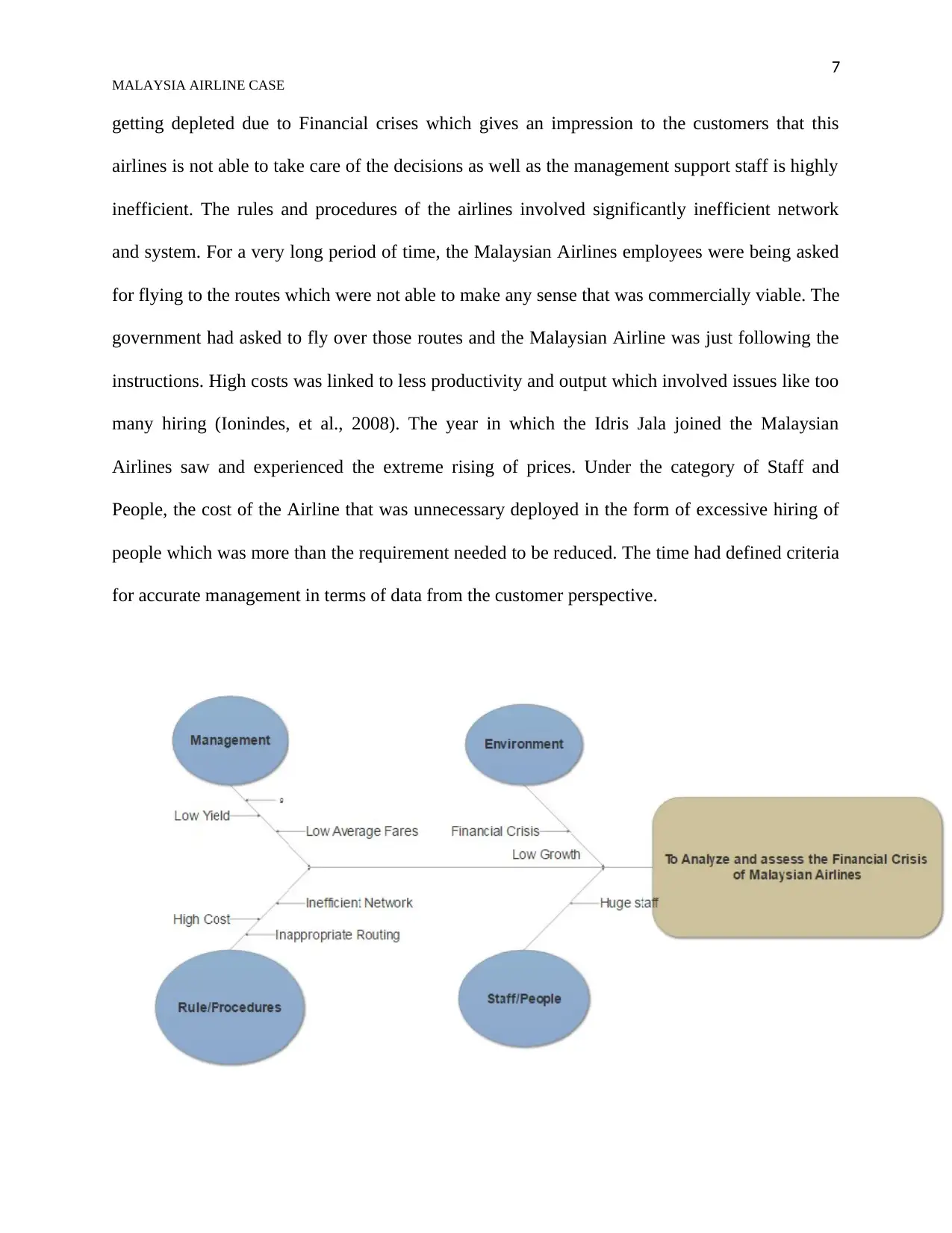
7
MALAYSIA AIRLINE CASE
getting depleted due to Financial crises which gives an impression to the customers that this
airlines is not able to take care of the decisions as well as the management support staff is highly
inefficient. The rules and procedures of the airlines involved significantly inefficient network
and system. For a very long period of time, the Malaysian Airlines employees were being asked
for flying to the routes which were not able to make any sense that was commercially viable. The
government had asked to fly over those routes and the Malaysian Airline was just following the
instructions. High costs was linked to less productivity and output which involved issues like too
many hiring (Ionindes, et al., 2008). The year in which the Idris Jala joined the Malaysian
Airlines saw and experienced the extreme rising of prices. Under the category of Staff and
People, the cost of the Airline that was unnecessary deployed in the form of excessive hiring of
people which was more than the requirement needed to be reduced. The time had defined criteria
for accurate management in terms of data from the customer perspective.
MALAYSIA AIRLINE CASE
getting depleted due to Financial crises which gives an impression to the customers that this
airlines is not able to take care of the decisions as well as the management support staff is highly
inefficient. The rules and procedures of the airlines involved significantly inefficient network
and system. For a very long period of time, the Malaysian Airlines employees were being asked
for flying to the routes which were not able to make any sense that was commercially viable. The
government had asked to fly over those routes and the Malaysian Airline was just following the
instructions. High costs was linked to less productivity and output which involved issues like too
many hiring (Ionindes, et al., 2008). The year in which the Idris Jala joined the Malaysian
Airlines saw and experienced the extreme rising of prices. Under the category of Staff and
People, the cost of the Airline that was unnecessary deployed in the form of excessive hiring of
people which was more than the requirement needed to be reduced. The time had defined criteria
for accurate management in terms of data from the customer perspective.
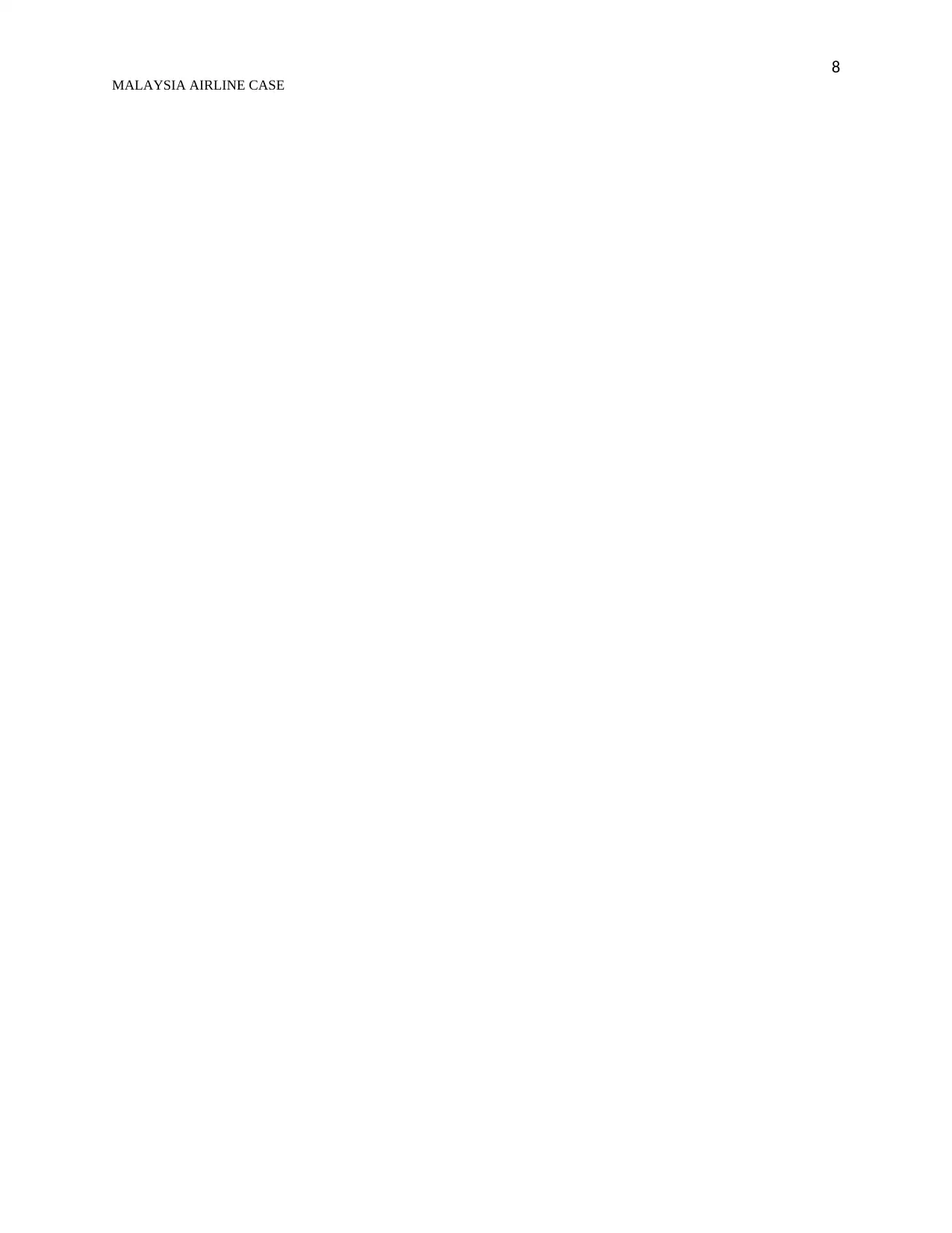
8
MALAYSIA AIRLINE CASE
MALAYSIA AIRLINE CASE
⊘ This is a preview!⊘
Do you want full access?
Subscribe today to unlock all pages.

Trusted by 1+ million students worldwide
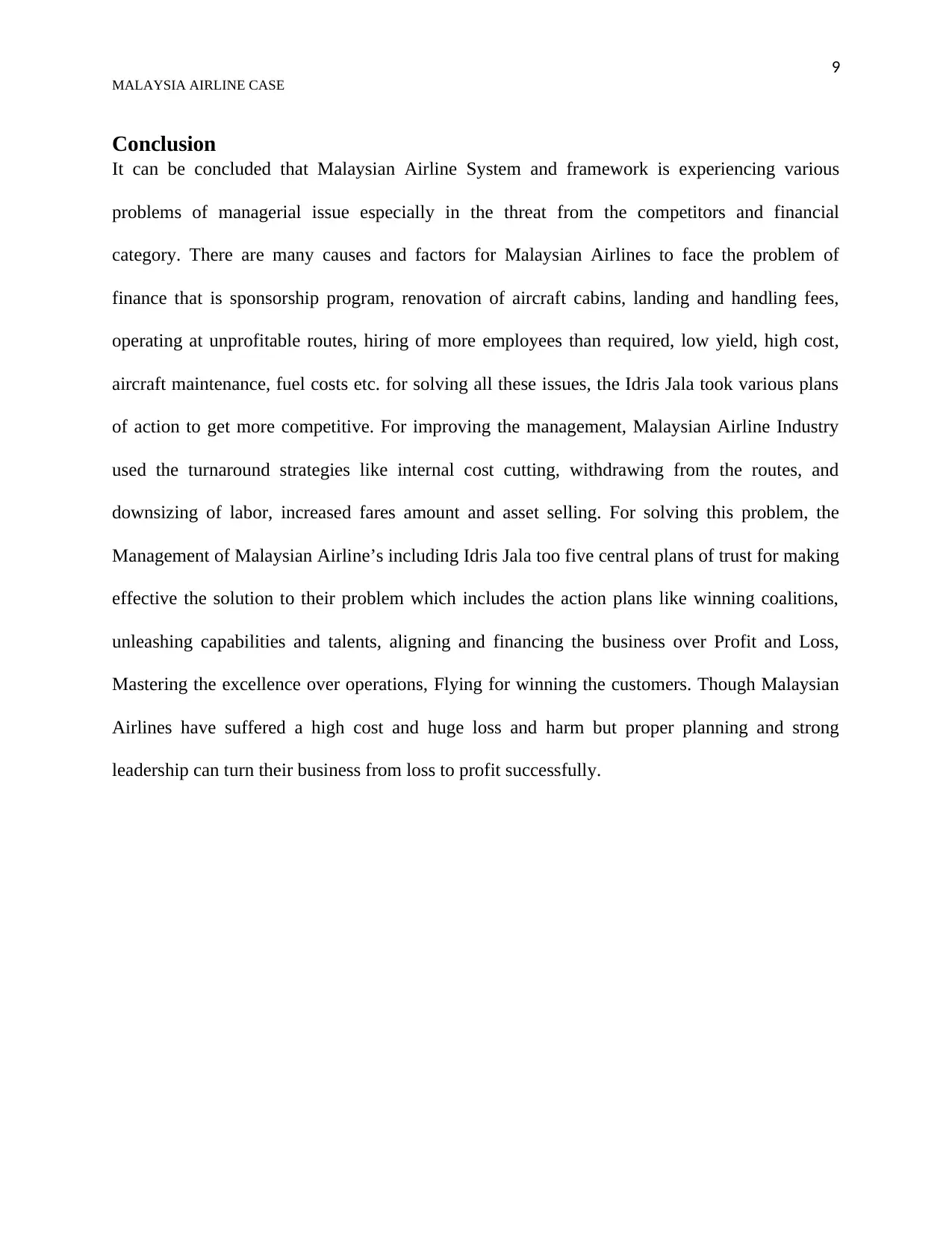
9
MALAYSIA AIRLINE CASE
Conclusion
It can be concluded that Malaysian Airline System and framework is experiencing various
problems of managerial issue especially in the threat from the competitors and financial
category. There are many causes and factors for Malaysian Airlines to face the problem of
finance that is sponsorship program, renovation of aircraft cabins, landing and handling fees,
operating at unprofitable routes, hiring of more employees than required, low yield, high cost,
aircraft maintenance, fuel costs etc. for solving all these issues, the Idris Jala took various plans
of action to get more competitive. For improving the management, Malaysian Airline Industry
used the turnaround strategies like internal cost cutting, withdrawing from the routes, and
downsizing of labor, increased fares amount and asset selling. For solving this problem, the
Management of Malaysian Airline’s including Idris Jala too five central plans of trust for making
effective the solution to their problem which includes the action plans like winning coalitions,
unleashing capabilities and talents, aligning and financing the business over Profit and Loss,
Mastering the excellence over operations, Flying for winning the customers. Though Malaysian
Airlines have suffered a high cost and huge loss and harm but proper planning and strong
leadership can turn their business from loss to profit successfully.
MALAYSIA AIRLINE CASE
Conclusion
It can be concluded that Malaysian Airline System and framework is experiencing various
problems of managerial issue especially in the threat from the competitors and financial
category. There are many causes and factors for Malaysian Airlines to face the problem of
finance that is sponsorship program, renovation of aircraft cabins, landing and handling fees,
operating at unprofitable routes, hiring of more employees than required, low yield, high cost,
aircraft maintenance, fuel costs etc. for solving all these issues, the Idris Jala took various plans
of action to get more competitive. For improving the management, Malaysian Airline Industry
used the turnaround strategies like internal cost cutting, withdrawing from the routes, and
downsizing of labor, increased fares amount and asset selling. For solving this problem, the
Management of Malaysian Airline’s including Idris Jala too five central plans of trust for making
effective the solution to their problem which includes the action plans like winning coalitions,
unleashing capabilities and talents, aligning and financing the business over Profit and Loss,
Mastering the excellence over operations, Flying for winning the customers. Though Malaysian
Airlines have suffered a high cost and huge loss and harm but proper planning and strong
leadership can turn their business from loss to profit successfully.
Paraphrase This Document
Need a fresh take? Get an instant paraphrase of this document with our AI Paraphraser
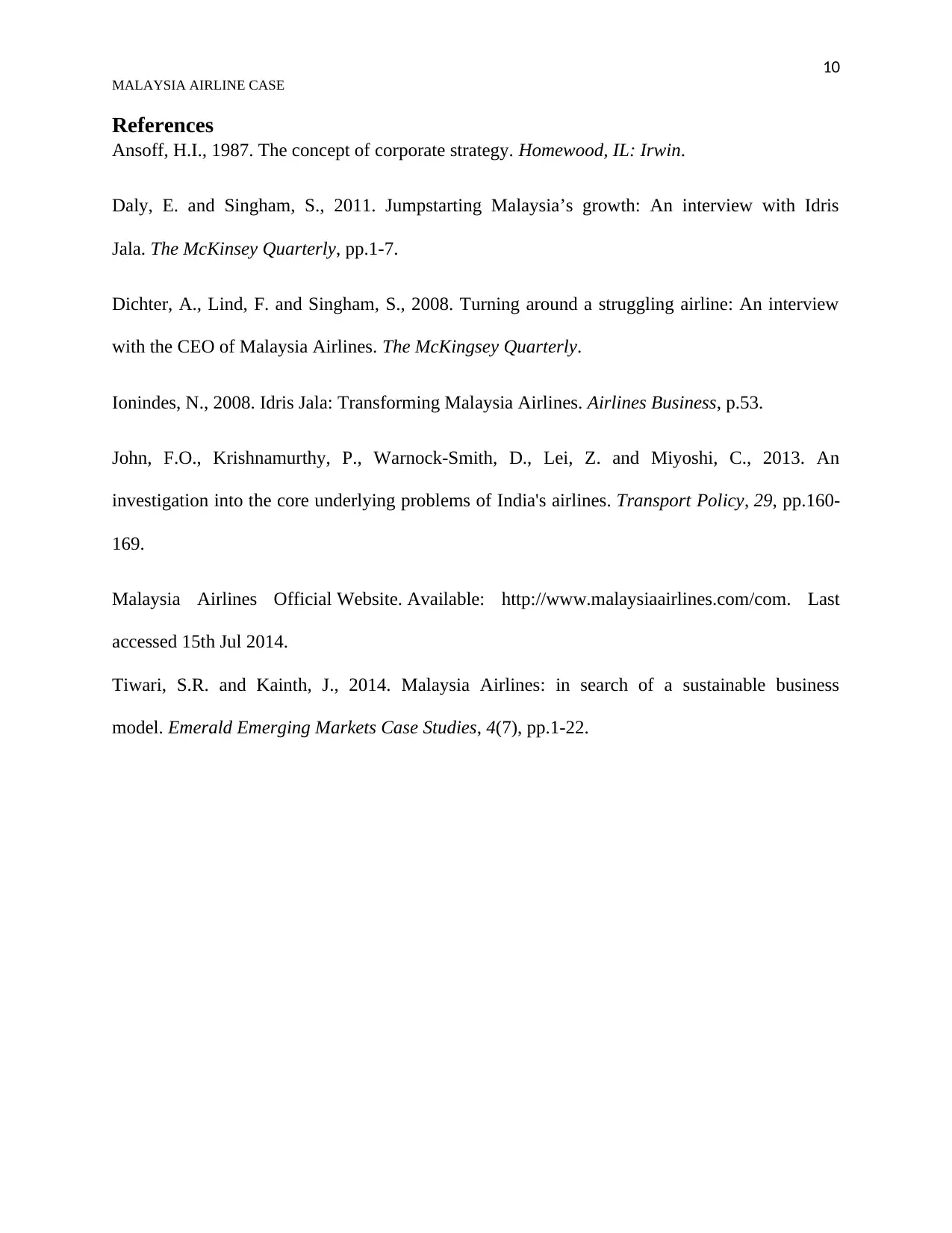
10
MALAYSIA AIRLINE CASE
References
Ansoff, H.I., 1987. The concept of corporate strategy. Homewood, IL: Irwin.
Daly, E. and Singham, S., 2011. Jumpstarting Malaysia’s growth: An interview with Idris
Jala. The McKinsey Quarterly, pp.1-7.
Dichter, A., Lind, F. and Singham, S., 2008. Turning around a struggling airline: An interview
with the CEO of Malaysia Airlines. The McKingsey Quarterly.
Ionindes, N., 2008. Idris Jala: Transforming Malaysia Airlines. Airlines Business, p.53.
John, F.O., Krishnamurthy, P., Warnock-Smith, D., Lei, Z. and Miyoshi, C., 2013. An
investigation into the core underlying problems of India's airlines. Transport Policy, 29, pp.160-
169.
Malaysia Airlines Official Website. Available: http://www.malaysiaairlines.com/com. Last
accessed 15th Jul 2014.
Tiwari, S.R. and Kainth, J., 2014. Malaysia Airlines: in search of a sustainable business
model. Emerald Emerging Markets Case Studies, 4(7), pp.1-22.
MALAYSIA AIRLINE CASE
References
Ansoff, H.I., 1987. The concept of corporate strategy. Homewood, IL: Irwin.
Daly, E. and Singham, S., 2011. Jumpstarting Malaysia’s growth: An interview with Idris
Jala. The McKinsey Quarterly, pp.1-7.
Dichter, A., Lind, F. and Singham, S., 2008. Turning around a struggling airline: An interview
with the CEO of Malaysia Airlines. The McKingsey Quarterly.
Ionindes, N., 2008. Idris Jala: Transforming Malaysia Airlines. Airlines Business, p.53.
John, F.O., Krishnamurthy, P., Warnock-Smith, D., Lei, Z. and Miyoshi, C., 2013. An
investigation into the core underlying problems of India's airlines. Transport Policy, 29, pp.160-
169.
Malaysia Airlines Official Website. Available: http://www.malaysiaairlines.com/com. Last
accessed 15th Jul 2014.
Tiwari, S.R. and Kainth, J., 2014. Malaysia Airlines: in search of a sustainable business
model. Emerald Emerging Markets Case Studies, 4(7), pp.1-22.
1 out of 11
Related Documents
Your All-in-One AI-Powered Toolkit for Academic Success.
+13062052269
info@desklib.com
Available 24*7 on WhatsApp / Email
![[object Object]](/_next/static/media/star-bottom.7253800d.svg)
Unlock your academic potential
Copyright © 2020–2026 A2Z Services. All Rights Reserved. Developed and managed by ZUCOL.





